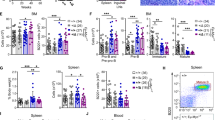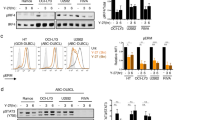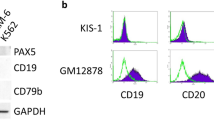Abstract
Deregulated expression of BCL6 is a pathogenic event in many lymphomas. BCL6 blocks cellular differentiation by repressing transcription of its target genes, and this may promote tumorigenesis. Conversely, the transcription factor signal transducers and activators of transcription (STAT)5 promotes differentiation in many systems. STAT5 upregulates a number of genes repressed by BCL6, raising the possibility that STAT5 and BCL6 have opposing roles in transcriptional regulation. Therefore, we sought to determine the effects of STAT5 activation on BCL6 expression and function. We found that activation of STAT5 downregulates BCL6 expression in B-lymphoma cells and other hematopoietic cell lines. We identified two potential STAT-binding regions in the first exon and first intron of BCL6 that fell within regions of high inter-species homology, suggesting conservation of regulatory function. STAT5 can bind inducibly and regulate transcription at one of these regions, identifying BCL6 as a STAT5 target gene. Additionally, STAT5-mediated downregulation of BCL6 results in loss of BCL6 repression of its target genes, confirming that STAT5 is a negative regulator of BCL6 function. The STAT5 responsive region of the BCL6 gene is mutated frequently in B-cell lymphomas, suggesting that loss of the repressive effects of STAT5 on BCL6 might contribute to the pathogenesis of these cancers.
This is a preview of subscription content, access via your institution
Access options
Subscribe to this journal
Receive 50 print issues and online access
$259.00 per year
only $5.18 per issue
Buy this article
- Purchase on Springer Link
- Instant access to full article PDF
Prices may be subject to local taxes which are calculated during checkout






Similar content being viewed by others
References
Alvarez JV, Febbo PG, Ramaswamy S, Loda M, Richardson A, Frank DA . (2005). Cancer Res 65: 5054–5062.
Bajalica-Lagercrantz S, Piehl F, Lagercrantz J, Lindahl J, Weber G, Kerckeart JP et al. (1997). Leukemia 11: 594–598.
Baron BW, Anastasi J, Montag A, Huo D, Baron RM, Karrison T et al. (2004). Proc Natl Acad Sci USA 101: 14198–14203.
Baron BW, Nucifora G, McCabe N, Espinosa III R, Le Beau MM, McKeithan TW . (1993). Proc Natl Acad Sci USA 90: 5262–5266.
Battle TE, Frank DA . (2003). Blood 102: 3016–3024.
Bowman T, Garcia R, Turkson J, Jove R . (2000). Oncogene 19: 2474–2488.
Brudno M, Poliakov A, Salamov A, Cooper GM, Sidow A, Rubin EM et al. (2004). Genome Res 14: 685–692.
Buitenhuis M, Baltus B, Lammers JW, Coffer PJ, Koenderman L . (2003). Blood 101: 134–142.
Cattoretti G, Pasqualucci L, Ballon G, Tam W, Nandula SV, Shen Q et al. (2005). Cancer Cell 7: 445–455.
Chaganti SR, Chen W, Parsa N, Offit K, Louie DC, Dalla-Favera R et al. (1998). Genes Chromosomes Cancer 23: 323–327.
Chen W, Iida S, Louie DC, Dalla-Favera R, Chaganti RS . (1998). Blood 91: 603–607.
Cui Y, Riedlinger G, Miyoshi K, Tang W, Li C, Deng CX et al. (2004). Mol Cell Biol 24: 8037–8047.
Darnell Jr JE . (1997). Science 277: 1630–1635.
de Groot RP, Raaijmakers JA, Lammers JW, Jove R, Koenderman L . (1999). Blood 94: 1108–1112.
Druker BJ, Tamura S, Buchdunger E, Ohno S, Segal GM, Fanning S et al. (1996). Nat Med 2: 561–566.
Fernandez de Mattos S, Essafi A, Soeiro I, Pietersen AM, Birkenkamp KU, Edwards CS et al. (2004). Mol Cell Biol 24: 10058–10071.
Frank DA . (1999). Mol Med 5: 432–456.
Frank DA, Robertson MJ, Bonni A, Ritz J, Greenberg ME . (1995). Proc Natl Acad Sci USA 92: 7779–7783.
Fujita N, Jaye DL, Geigerman C, Akyildiz A, Mooney MR, Boss JM et al. (2004). Cell 119: 75–86.
Gesbert F, Griffin JD . (2000). Blood 96: 2269–2276.
Happ B, Groner B . (1993). J Steroid Biochem Mol Biol 47: 21–30.
Hardison RC, Oeltjen J, Miller W . (1997). Genome Res 7: 959–966.
Horvath CM . (2000). Trends Biochem Sci 25: 496–502.
Ichinohasama R, Miura I, Funato T, Sato I, Suzuki C, Saito Y et al. (1998). Cancer Genet Cytogenet 104: 19–27.
Ilaria RLJ, Hawly RG, Van Etten RA . (1999). Blood 93: 4154–4166.
Kerckaert JP, Deweindt C, Tilly H, Quief S, Lecocq G, Bastard C . (1993). Nat Genet 5: 66–70.
Kikuchi M, Miki T, Kumagai T, Fukuda T, Kamiyama R, Miyasaka N et al. (2000). Oncogene 19: 4941–4945.
Leong PL, Xi S, Drenning SD, Dyer KF, Wentzel AL, Lerner EC et al. (2002). Oncogene 21: 2846–2853.
Lin TS, Mahajan S, Frank DA . (2000). Oncogene 19: 2496–2504.
Liu X, Robinson GW, Gouilleux F, Groner B, Hennighausen L . (1995). Proc Natl Acad Sci USA 92: 8831–8835.
Logarajah S, Hunter P, Kraman M, Steele D, Lakhani S, Bobrow L et al. (2003). Oncogene 22: 5572–5578.
Lossos IS, Akasaka T, Martinez-Climent JA, Siebert R, Levy R . (2003). Leukemia 17: 1390–1397.
Lozzio CB, Lozzio BB . (1975). Blood 45: 321–334.
Luo G, Yu-Lee L . (1997). J Biol Chem 272: 26841–26849.
Matsumoto A, Masuhara M, Mitsui K, Yokouchi M, Ohtsubo M, Misawa H et al. (1997). Blood 89: 3148–3154.
Melzner I, Bucur AJ, Bruderlein S, Dorsch K, Hasel C, Barth TF et al. (2005). Blood 105: 2535–2542.
Messika EJ, Lu PS, Sung YJ, Yao T, Chi JT, Chien YH et al. (1998). J Exp Med 188: 515–525.
Migliazza A, Martinotti S, Chen W, Fusco C, Ye BH, Knowles DM et al. (1995). Proc Natl Acad Sci USA 92: 12520–12524.
Moriggl R, Sexl V, Kenner L, Duntsch C, Stangl K, Gingras S et al. (2005). Cancer Cell 7: 87–99.
Nakajima H, Brindle PK, Handa M, Ihle JN . (2001). EMBO J 20: 6836–6844.
Nelson EA, Walker SR, Alvarez JA, Frank DA . (2004). J Biol Chem 279: 54724–54730.
Niu H, Cattoretti G, Dalla-Favera R . (2003). J Exp Med 198: 211–221.
Nosaka T, Kawashima T, Misawa K, Ikuta K, Mui AL-F, Kitamura T . (1999). EMBO J 18: 4754–4765.
Ohashi K, Miki T, Hirosawa S, Aoki N . (1995). Biochem Biophys Res Commun 214: 461–467.
Onishi M, Nosaka T, Misawa K, Mui AL-F, Gorman D, McMahon M et al. (1998). Mol Cell Biol 18: 3871–3879.
Otaki JM, Fearon DT, Yamamoto H . (2005). Neurosci Res 53: 189–200.
Pasqualucci L, Migliazza A, Basso K, Houldsworth J, Chaganti RS, Dalla-Favera R . (2003). Blood 101: 2914–2923.
Rascle A, Johnston JA, Amati B . (2003). Mol Cell Biol 23: 4162–4173.
Robertson MJ, Cochran KJ, Cameron C, Le JM, Tantravahi R, Ritz J . (1996). Exp Hematol 24: 406–415.
Scheeren FA, Naspetti M, Diehl S, Schotte R, Nagasawa M, Wijnands E et al. (2005). Nat Immunol 6: 303–313.
Schuringa JJ, Chung KY, Morrone G, Moore MA . (2004). J Exp Med 200: 623–635.
Shaffer AL, Yu X, He Y, Boldrick J, Chan EP, Staudt LM . (2000). Immunity 13: 199–212.
Shipp MA, Ross KN, Tamayo P, Weng AP, Kutok JL, Aguiar RCT et al. (2002). Nat Med 8: 68–74.
Shuai K, Halpern J, ten Hoeve J, Rao X, Sawyers CL . (1996). Oncogene 13: 247–254.
Sillaber C, Gesbert F, Frank DA, Sattler M, Griffin JD . (2000). Blood 95: 2118–2125.
Socolovsky M, Fallon AE, Wang S, Brugnara C, Lodish HF . (1999). Cell 98: 181–191.
Tang TT, Dowbenko D, Jackson A, Toney L, Lewin DA, Dent AL et al. (2002). J Biol Chem 277: 14255–14265.
Teglund S, McKay C, Schuetz E, van Deursen JM, Stravopodis D, Wand D et al. (1998). Cell 93: 841–850.
Xi S, Zhang Q, Gooding WE, Smithgall TE, Grandis JR . (2003). Cancer Res 63: 6763–6771.
Ye BH, Chaganti S, Chang CC, Niu H, Corradini P, Chaganti RS et al. (1995). EMBO J 14: 6209–6217.
Ye BH, Rao PH, Chaganti RS, Dalla-Favera R . (1993). Cancer Res 53: 2732–2735.
Zhou G, Ono SJ . (2005). Exp Mol Pathol 78: 25–35.
Acknowledgements
This work was supported by the Brent Leahey Fund and the Friends of the Dana-Farber Cancer Institute.
Author information
Authors and Affiliations
Corresponding author
Additional information
Supplementary Information accompanies the paper on the Oncogene website (http://www.nature.com/onc).
Supplementary information
Rights and permissions
About this article
Cite this article
Walker, S., Nelson, E. & Frank, D. STAT5 represses BCL6 expression by binding to a regulatory region frequently mutated in lymphomas. Oncogene 26, 224–233 (2007). https://doi.org/10.1038/sj.onc.1209775
Received:
Revised:
Accepted:
Published:
Issue Date:
DOI: https://doi.org/10.1038/sj.onc.1209775
Keywords
This article is cited by
-
BTB protein family and human breast cancer: signaling pathways and clinical progress
Journal of Cancer Research and Clinical Oncology (2023)
-
STAT proteins: a kaleidoscope of canonical and non-canonical functions in immunity and cancer
Journal of Hematology & Oncology (2021)
-
Varroa destructor parasitism has a greater effect on proteome changes than the deformed wing virus and activates TGF-β signaling pathways
Scientific Reports (2019)
-
Bioinformatic identification and expression analysis of the chicken B cell lymphoma (BCL) gene
Genes & Genomics (2019)
-
Dynamic regulation of T follicular regulatory cell responses by interleukin 2 during influenza infection
Nature Immunology (2017)



